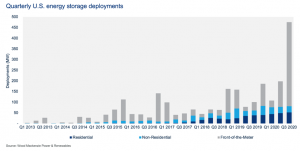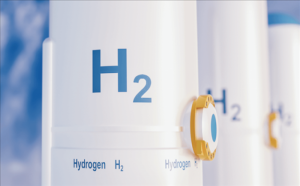In This Issue
- Flanigan’s Eco-Logic: Microgrids 1.1: The Basics
- Virtual Power Plants
- Recycling Wind Turbine Blades
- United Kingdom to Outpace California
- Denmark Stops North Sea Oil Exploration
- Protecting the Arctic
- Nordic Harvest’s Vertical Farm
- Energy Storage Rising
- Smart Pressure Management
- Green Hydrogen Update

Flanigan’s Eco-Logic: Microgrids 1.1: The Basics
This brief is the first in a ten-part series on Microgrids.
There are a number of key and catchy words in the energy and environmental world in which I live…algorithms, net zero, parity, equity, resilience…microgrids. I love them all, especially the latter as a consultant in that new and daring space. We’re spearheading a project to develop 32 energy-resilient, solar + storage systems now for Southern California cities. If the grid goes down, a facility can still function.
Microgrids are a hot topic because they provide energy resilience. In Monterey County, EcoMotion worked for a school district that sought resilience to keep its students from wasting an educational minute. We found a cost-effective means to finance solar coverage for every campus, battery energy storage, and microgrid controls. Supported by wireless energy management capabilities, the microgrids are designed to operate indefinitely in a carbon-free mode during a prolonged outage. This case study will be presented later in this series.
But let’s get back to basics: What are microgrids? Literally…they are really small grids. Some of them serve islands or ships and are autonomous, while others are tied to the grid and spring into action when the grid goes down. We’re going to focus on the latter:
For the purposes of this discussion and series, microgrids are facilities or geographic areas that can “island” from the power system and operate in parallel with and independently of the power system. We’ve developed solar + storage microgrids. Between the two, and tight controls, the microgrids can be operational and autonomous. They can be carbon-free. And they can be financed.
Thomas Edison started pretty small at the Pearl Street Generating Station in the financial district of Manhattan in New York City in 1882. Edison Illuminating Company’s coal-fired power plant originally served 400 streetlights and 82 customers. It was actually a cogeneration plant as steam heating was providing to adjacent manufacturers and buildings. It was a small grid…a microgrid…served by a single power source.
Later the Edison companies got bigger and bigger, with not only local distribution but also long-distance transmission tying in generators far away. As centralization of power generation occurred, gone was its cogeneration, and gone was resiliency. Unplanned outages cause widespread disruption. While tapping the economies of scale for power generation, the central systems that we largely rely on today in America fundamentally lack the resilience that lots of small systems create.
So back to microgrids and addressing today’s realities. Microgrids can augment and shore up the power system by being able to operate and provide power to critical loads. In the event of an emergency, they can provide for refrigeration, medical equipment, or IT systems and communication.
Many hospitals, police and fire stations are already energy resilient. They have generators – typically gas-fired or diesel – that operate only when the grid goes down. New age microgrids have day jobs. They can generate savings during normal times and serve highly valued resiliency during outages.
During Superstorm Sandy, there were few pockets of light in and around New York City. One such pocket of light was Coop City, a housing development in the Bronx. Its power plant is configured to run in sync with the grid in normal times, and to be able to generate on its own during outages. Normally, ConEd buys excess power from Coop City, but during the superstorm, it was fully functional in islanded mode. This case study of a money-making, quite large-scale microgrid will be presented later too.
A colleague that I admire, Peter Asmus of Navigant Research, stated the other day to me that the current state of microgrids is pretty clear: Everyone wants one. This is especially so in California where PSPS (Public Safety Power Shut-offs) events are wreaking havoc on homes and businesses. Imagine your utility telling you that they are shutting down for the next several days due to extreme conditions…so sorry. Really, this is a sorry state of affairs. Can carbon-free microgrids be designed so that they pay for themselves, and cover you when the grid goes down, planned or unplanned?
The next issue of this series will be “Microgrids 1.2: Microgrid Components.”



 Prime Minister Boris Johnson has recently proclaimed that the United Kingdom will cut its greenhouse gas emissions further and faster than any other major economy in the next decade, outpacing California. The U.K.’s new target reduction will be 68% in annual carbon emissions by 2030 compared to 1990 levels, a significant increase from the 57% previous target. In California, ten years after the infamous AB 32 Global Warming Solutions Act, SB ratcheted up the GHG reduction target to 40% below 1990 levels by 2030.
Prime Minister Boris Johnson has recently proclaimed that the United Kingdom will cut its greenhouse gas emissions further and faster than any other major economy in the next decade, outpacing California. The U.K.’s new target reduction will be 68% in annual carbon emissions by 2030 compared to 1990 levels, a significant increase from the 57% previous target. In California, ten years after the infamous AB 32 Global Warming Solutions Act, SB ratcheted up the GHG reduction target to 40% below 1990 levels by 2030.
 TD Bank – Toronto Dominion Bank – announced that it will no longer fund oil and gas related activities in the Arctic Circle. It is joining a number of major global lenders in taking similar action to protect the Arctic’s fragile ecosystem by cutting off funding for environmentally detrimental projects. Goldman Sachs, JPMorgan Chase, Wells Fargo, Citigroup, and Morgan Stanley have all committed to ending fossil-fuel financing in the Arctic.
TD Bank – Toronto Dominion Bank – announced that it will no longer fund oil and gas related activities in the Arctic Circle. It is joining a number of major global lenders in taking similar action to protect the Arctic’s fragile ecosystem by cutting off funding for environmentally detrimental projects. Goldman Sachs, JPMorgan Chase, Wells Fargo, Citigroup, and Morgan Stanley have all committed to ending fossil-fuel financing in the Arctic.

 InPipe is a company that harvests excess pressure in municipal water systems. Excess pressure and deferred maintenance are common themes in municipal water systems. The former exacerbates the latter. There are 240,000 U.S. water main breaks each year, according to the American Society of Civil Engineers, resulting in more than 2 trillion gallons of lost drinking water annually.
InPipe is a company that harvests excess pressure in municipal water systems. Excess pressure and deferred maintenance are common themes in municipal water systems. The former exacerbates the latter. There are 240,000 U.S. water main breaks each year, according to the American Society of Civil Engineers, resulting in more than 2 trillion gallons of lost drinking water annually. Developments in the green hydrogen space continue to be impressive. Reuters reports that a consortium of large companies has signed on to the United Nations Green Hydrogen Catapult Initiative. The project is part of the U.N. Race to Zero, an initiative urging companies to commit to environmental action outside of government frameworks. Its goal is to halve the cost of green hydrogen (which is now around $4/kgH2) to below $2/kG and to add 25 GW of capacity by 2026, fifty times more green hydrogen than is being currently produced.
Developments in the green hydrogen space continue to be impressive. Reuters reports that a consortium of large companies has signed on to the United Nations Green Hydrogen Catapult Initiative. The project is part of the U.N. Race to Zero, an initiative urging companies to commit to environmental action outside of government frameworks. Its goal is to halve the cost of green hydrogen (which is now around $4/kgH2) to below $2/kG and to add 25 GW of capacity by 2026, fifty times more green hydrogen than is being currently produced.